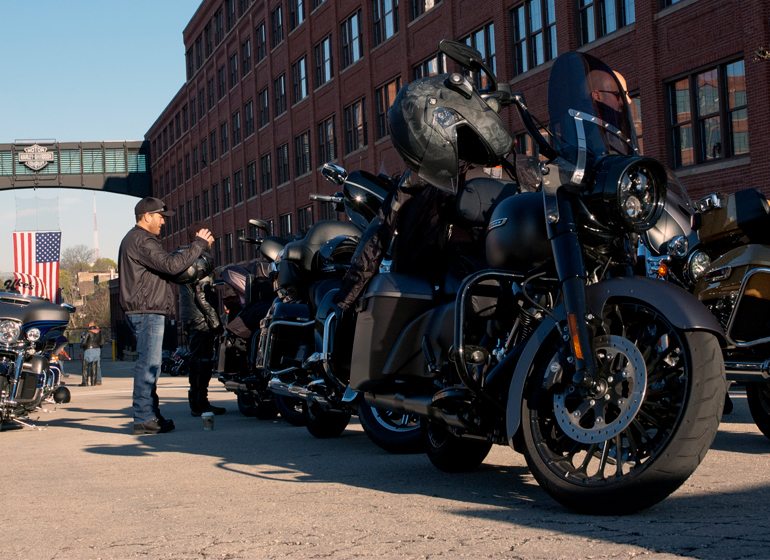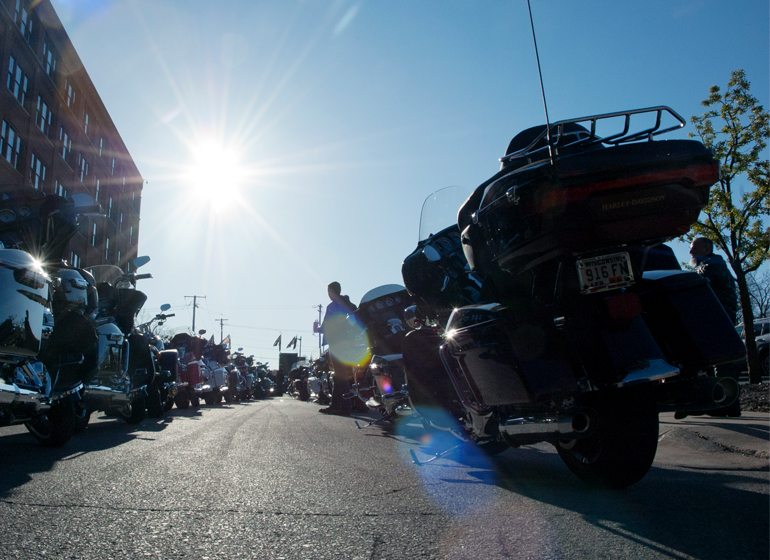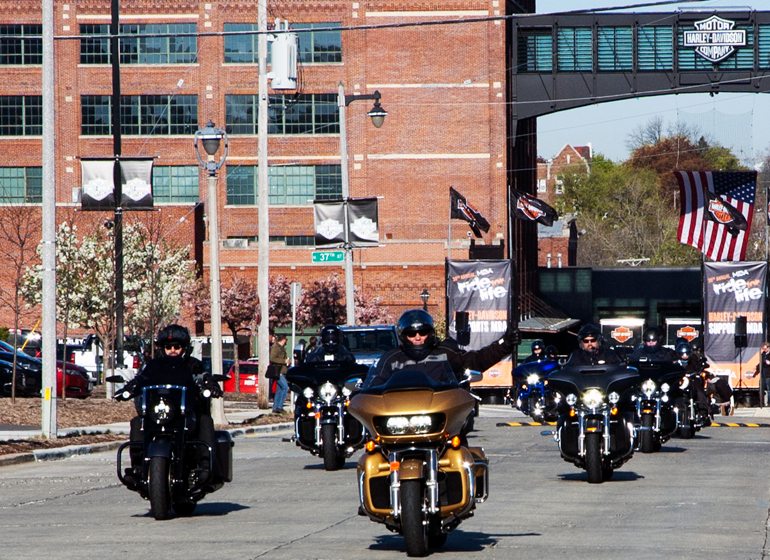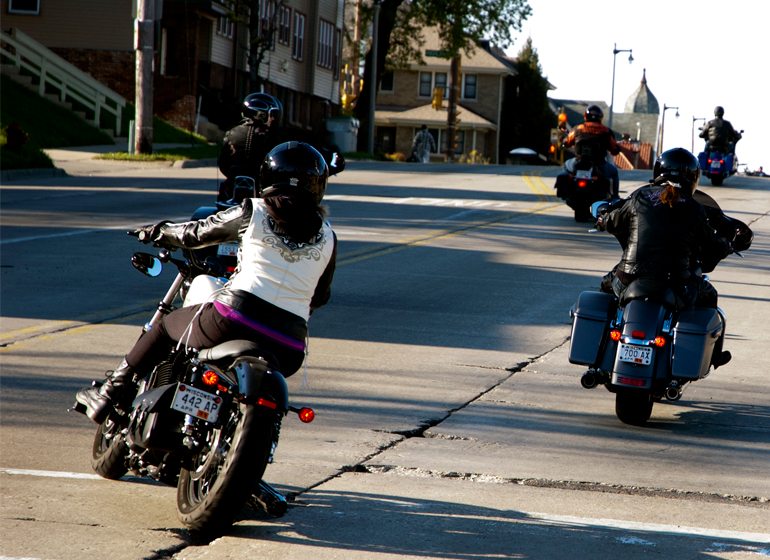The temperature may have been in the 40s, but that didn’t stop a group of about 75 Harley-Davidson riders, employees, retirees and dealers from showing up at the company’s Milwaukee headquarters on a brisk, bright morning in early May.
They were there to kick off the first leg of the 30th annual Muscular Dystrophy Association Ride for Life.

Most would only be heading to Uke’s Harley-Davidson in Kenosha, but 16 were starting on a much longer journey, riding to Fort Wayne, Indiana the first day and then on to Leesport, Pennsylvania over the following days as part of a 1,000-mile journey, with stops at Harley dealers and factories along the way.
Group rides are part of the Harley-Davidson culture. Another ride will set out later this summer from Milwaukee destined for Minneapolis. Chief executive officer Matt Levatich will be on that ride with others from the company, heading to the X Games, where Harley is sponsoring flat track motorcycle racing.
There will be thousands of other rides around the country before next year’s big ride, when riders descend on Milwaukee Labor Day weekend for Harley’s 115th anniversary celebration.
But as much as group rides are a tradition for Harley riders, especially older ones, Robert Moakley, owner of Wisconsin Harley-Davidson in Oconomowoc, says he’s seen a trend emerging among younger riders.
“You don’t really see them doing big group rides,” he said. “So the question is, do we adapt to that or do they adapt to the group ride function?”
Moakley’s guess is that group rides will become more attractive to younger riders as they age.
The bigger question of how Harley-Davidson’s brand will translate to future generations is certainly an open one. The baby-boom generation helped fuel year after year of double-digit growth in Harley’s sales and motorcycle shipments throughout the ’90s and early 2000s. The youngest of that generation will turn 53 this year and the oldest will reach 71, an age at which heading out on the open road, or at least investing in a new motorcycle, may not be as appealing as it once was.
“As boomers age, Harley can either add new riders or see its brand wear thin, like your go-to biker chaps,” a recent Robert W. Baird & Co. Inc. research report noted.

Among the many challenges Harley faces is meeting the needs and wants of its current customers while also expanding its offering into new areas that help attract younger generations. It’s certainly a balancing act the company is aware of, disclosing it as a risk factor in its securities filings.
Harley also unveiled a new 10-year strategy earlier this year, with the goal of “building the next generation of riders, globally.”
The plan calls for creating 2 million new riders in the United States, growing the international portion of the business to 50 percent of the total, launching 100 new “high-impact” models, providing return on invested capital in the top 25 percent of the S&P 500 and doing it all without increasing the company’s environmental impact.
The plan is the result of a lot of work Harley has done in recent years to improve its manufacturing efficiency and its product development, but it is also a response to increasing challenges from a variety of corners and a shift toward focusing on driving demand.
Levatich took over as chief executive officer in May 2015, and the past two years have presented him and Harley with outside challenges that have required tough decisions. The strengthening of the U.S. dollar in late 2014 made it more difficult for Harley to sell motorcycles overseas profitably and made it easier for non-U.S. players to compete on Harley’s home turf.
Polaris Industries Inc. also has been able to grow sales in its motorcycle business from almost $220 million in 2013, when the Indian Motorcycle brand was relaunched, to $708.5 million last year. The Minnesota-based company will be able to invest more in Indian now, after announcing the wind down of Victory Motorcycles earlier this year.
A refocused domestic competitor combined with relatively more favorable conditions for international competitors is one thing, but Levatich said many of Harley’s competitors came out of the economic downturn “with their feet under them on new product development,” making an already challenging situation more difficult.
“I like what we were set up to do to face that. I wish we had seen it, acted and amended sooner, but we built some great fundamental capabilities coming out of the downturn,” Levatich said. “We had worked on core strengths and we were prepared in a way that we might not have otherwise been prepared to do what we did next, which was to pivot our efforts as a company toward driving demand.”
The pivot toward driving demand started in late 2015, with the announcement of an additional $70 million in spending on product development and consumer-facing marketing. Harley started 2016 with a new emphasis on driving demand for its motorcycles and was working on the development of its new Milwaukee Eight engine. Then, in the middle of the second quarter, the industry took a downturn. Weakness in oil-dependent regions, combined with uncertainty from the presidential election, likely contributed. The result was elevated levels of model year 2016 motorcycles at dealerships just as the company shipped 2017 models with a brand new, upgraded engine.
“We in no way expected or predicted the market to sort of shut off and we were left with more inventory than we wanted to have at a critical time in the year,” Levatich said.
Harley was forced to hold back on shipments at the beginning of 2017 and instead help dealers sell through their 2016 model year motorcycles.
“It was a difficult couple of years, but in a way, a really fruitful couple of years, because it sharpened our capabilities and sharpened our focus about what we have to do in the next decade,” Levatich said.
The experience shows how “business in general has to be quicker on its feet than it’s ever had to be,” Levatich said.
“We just don’t live in a world anymore that is predictable, as predictable as most people in business are accustomed,” he said, noting the constant change plays into every decision, from where to deploy capital to what kind of talent to hire.
“I think it’s an issue for us as a people, as a society,” Levatich said. “How do we get good at living in a dynamic world? How does it not create anxiety, but excitement? These are issues many companies will soon be dealing with in a major way.”
Levatich isn’t one to back away from a challenge. When he talks about his approach to business, it is almost as if he’s describing the feeling of riding a Harley.
“My objective has always been learning, growth, exposure, challenge,” he said. “I like the feeling of being as close to the edge as possible and being really challenged in that, and I find that the learning is most fulfilling there.”
Levatich grew up riding dirt bikes in central New York and while he loved to ride, he never aspired to work at Harley-Davidson. His career passion was more about manufacturing, and Levatich realized he had more to learn as he became involved in the business of the industry. That led him to the business school at Northwestern University and eventually, an interview with Harley. The opportunity with Harley combined his love of riding with his interest in design and fascination with brands.
The company he joined in 1994 looked a lot different than the one he leads today. At that time, Harley had a transportation vehicles segment that sold Holiday Rambler RVs, Utilimaster commercial vehicles and even some office furniture. The company shipped 95,811 motorcycles and was in the midst of a three-year effort to produce 100,000 motorcycles in a single year by 1996.
Harley shipped 262,221 motorcycles last year, down about 3 percent from two years ago and 25 percent from nearly 350,000 when shipments peaked in 2006.
It is probably a good thing for Harley that Levatich is so willing to embrace a challenge. From growing new riders and building the brand internationally, to developing new models and confronting increased competition, Harley is taking on an ambitious set of tasks in the coming year.

“Competition, to me, is exciting; it’s welcome. I’m loving what I’m seeing from the organization in our response,” Levatich said. “I absolutely, firmly (believe) our best years are in front of us.”
If Levatich is right, the coming years could be quite profitable for Harley and its shareholders, considering the company is starting from a much different place than when its growth took off in the ’90s.
Growing Riders
Sam Petre checks many of the boxes Harley talks about when it comes to bringing new people to its brand. The self-described motorcycle addict is 35 years old and lives in Wauwatosa. He last owned a motorcycle in 2009 and was saving for another one until children came along and those resources were pushed in another direction.
Even without a motorcycle of his own, Petre, director of Milwaukee-based gener8tor’s gBETA Beloit, has continued to follow the motorcycle industry. If he were to buy a bike now, it probably wouldn’t be a Harley.
“The ones that are most intriguing to me are just a little bit more raw,” Petre said.
Of course, he comes from a different part of the motorcycle world, having been a sport bike rider most of his life. Petre acknowledged having a very negative perception of Harley when he lived in other parts of the country.
“I just knew that it was a bunch of old, fat white guys who didn’t know how to turn,” he said.
A job as a staff designer at former Harley subsidiary Buell Motorcycle Co. brought him to Wisconsin, where a combination of rolling country roads and the Harley-
Davidson Museum helped him gain an appreciation for the brand.
“It wasn’t until I moved to Wisconsin that I understood the allure of Harley,” Petre said.
He pointed out one of the biggest challenges for the motorcycle industry in the U.S. is there is no real incentive to buy one. While much of the rest of the world uses smaller motorcycles for transportation, the U.S. is much more car-centric. Some people may grow up riding dirt bikes or mini bikes, but many have no exposure to the sport.
“There’s no clear funnel for them from an early customer attraction standpoint,” Petre said.
The 2 million new riders Harley hopes to attract over the next 10 years isn’t a goal pulled out of thin air. It’s the product of $6 million invested in consumer research last year, along with other insights the company has developed. Harley estimates there are currently 2.4 million riders who own a competitor’s motorcycle but have interest in buying a Harley in the next three years. Another group of 15 million, classified as motorcycle intenders, are planning to purchase a motorcycle in the next three years and have an interest in Harley. Some of those in that group are part of the 7.8 million the company estimates have a motorcycle license but no bike.
The reality is around 3 percent of U.S. adults ride motorcycles. Levatich isn’t looking to grow that figure to 10 percent, he just wants to be able to walk into a gathering and have three out of 100 people raise their hands as motorcycle riders.
“I don’t think it is cool if 10 hands of 100 go up,” he said. “This is something for people that actually are making a statement about who they are and how they want to live and be.”
But even if Levatich isn’t looking to more than triple the sport of motorcycling in the U.S., Harley’s success does depend on shifting the company’s focus toward building riders.
“We need riders. That’s sort of a simple idea; I’m not saying it’s a simple solution, but the fact of the matter is we need to shift our attention as a company, in particular in the United States, from ‘we build motorcycles’ to ‘we build riders,’” Levatich said. “When we build riders, motorcycles will sell. If you just build motorcycles, you may not sell them.”
Focusing on demand means all kinds of things. From increased advertising in targeted markets to sponsoring flat track racing at the X Games, Harley is increasing its consumer-facing marketing. Advertising expenses have been up double digits each of the past four years, from $81 million in 2012 to $137 million last year.

The company is also refining its approach to its Rider Academy, seeking to increase the number of people who buy a motorcycle after completing the class. Chief financial officer John Olin acknowledged on a recent earnings call that the company would be making changes after offering the program free to military, police, fire and first responders last year.
“One of the learnings is when you offer things free, some people don’t – they go to have something to do,” Olin said.
Moakley said about 16 or 18 percent of the people who take the class end up buying a motorcycle. His internal goal is to reach 20 percent and eventually, 25 percent. He plans on investing about $1 million to build a training range at his dealership.
Riding in a parking lot is one thing, but going out on the road is another, so Harley executives have talked about adding some additional programming to bridge the gap. The challenge is also figuring out how to help people go from learning to ride to having the confidence to buy a motorcycle of their own.
The least expensive model, the Street 500, starts at $6,849, but some used motorcycles can be had for less than that. Sales of used motorcycles accounted for 71 percent of the 563,000 Harleys that changed owners last year.
Prices for used motorcycles have softened over the past year, and Baird’s research reports note more used motorcycles will hit the market as baby boomers exit their riding years, potentially offering a more affordable avenue for new riders.
“You could make the statement that used Harleys are the biggest competitor to Harley-Davidson’s new sales in the United States,” Levatich said “I’d rather think it’s the biggest asset we have to bring new riders into the sport.”
The company also hopes to grow new riders by strengthening its U.S. dealer network. That will include facility upgrades, an enhanced retail experience and sharing of best practices. Many dealers regularly hold events at their dealerships that can help draw new people to the sport.
“I think the events are sort of demystifying Harley-Davidson, because at the core, they’re all good people and I think people that don’t ride or aren’t familiar with the lifestyle, they can get a flavor for it at those events,” Moakley said.
He added dealerships increasingly need to have people on their sales floor who are personable, knowledgeable and approachable.
“I think that’s something the dealerships didn’t do well, the approachable part, in the distant past,” Moakley said. “When there was a waitlist for a bike, it didn’t really challenge your skills as a salesperson; you sold every bike that came through the door. We still sell every bike that comes through the door, it’s just (now) you have to be able to connect with the customer.”
Harley is also looking to its current customers to bring new people into the sport, using terms like “activate the base” or “enlist the army.” Levatich said that means encouraging new riders to try the sport and getting existing riders out on the road.

“When I’m riding on my bike or I’m at a gas station on my bike, someone’s saying, ‘Hey, look at that cool bike; I want to ride.’ If I’m there in my pickup truck, the person isn’t having that thought,” he said.
When Levatich’s sons were growing up, he didn’t want to push motorcycling on them, opting to allow them to pursue their own interests instead. So even though there were always bikes around, neither gravitated to the sport. It wasn’t until his older son went off to college and a roommate from Japan found out his dad worked at Harley that the interest sparked. His son returned home from freshman year and told his dad he wanted to learn to ride. Levatich’s other son followed a similar pattern, and now both seek out their dad’s advice in gaining experience. They’re able to ride in front of Levatich and he can teach them through helmet-to-helmet communications. He called it an “awesome discovery” that his sons wanted his input and responded to his teaching.
“It is very gratifying to a passionate motorcyclist when someone else picks up the baton and wants to run with it and wants your help,” he said. “This is a father-son example, but it plays out all the time.”
New Models
Harley has already increased its investment in research and development by 25 percent in the past two years. At $172.3 million, 2016 R&D spending was at its highest level since 2007. The company plans to continue to invest as it develops 100 new models in the coming years.
When Levatich talks about Harley’s product development plans, he’s quick to downplay the importance of the specific number. Instead, he puts the emphasis on the need for “high-impact” new models.
“We aim to reinvent product segments where we’re strong and offer alternatives in adjacent segments,” Levatich said at the company’s annual meeting. “Our new bikes will be designed to bridge the desires of riders of different ages, genders and cultures.”
He said not every new model will appeal to every rider. Harley’s targets include its core domestic customers, outreach customers in the U.S. and international riders in emerging and developed markets. Each new model is intended for at least two of those targets. For example, the Street platform is primarily targeted toward growth opportunities in Asia, but it also helps with outreach in the U.S.
The company also plans to broaden the customer needs its motorcycles fulfill. Some riders may be looking for laid-back cruising; others want tucked-in speed and adrenaline. Some might be riding on city streets; others want to head out on long journeys.
“Not every one that we do will appeal to everybody, and that’s actually important, not just to acknowledge that, but to actually embrace that,” Levatich said. “We’re not going to create a motorcycle that everybody is going to love.”

Moakley said the company is increasingly realizing everyone is a potential customer and that will be good in the long-run.
“I think there used to be, I don’t want to say a fear, but at least a hesitation, to do things that they thought might have alienated their core customers. I think they’ve gotten rid of that,” he said.
Levatich said Livewire, Harley’s electric motorcycle that has yet to be introduced as a production model, will likely appeal to both passionate riders and people who have never been on a motorcycle.
“As an investment in a product, it’s not singularly about people that have never ridden before, nor is it singularly about people that have always ridden, but it probably is more about getting new people on two wheels,” he said.
While Harley executives have spoken a lot in recent months about product development plans, those statements haven’t gone into great detail on specific segments or projects. Livewire, which was first introduced as a concept in 2014, is no different.
“All I can say is the electric bike is a project that is active on that lifecycle plan,” Levatich said at the annual meeting. “We don’t typically commit to the timing of products because there’s a lot of work in development that can influence the timing. It is an active project in our portfolio and we expect it to come to market.”
Levatich said Livewire is the most exciting automotive-related product he’s ever experienced and is easier to ride than a bicycle.
Growing International Markets
Harley’s latest investor presentation features a slide with a pie chart showing the total number of motorcycles in the world. A small black sliver represents the roughly 8 million on the road in the U.S. A slightly larger slice represents the developed markets of Europe, Canada, Japan and Australia. Finally, a large orange piece covering more than three-quarters of the chart represents motorcycles used in China, India and southeast Asia.
Levatich said no one is spending enough time thinking about that large orange portion. He pointed to Vietnam, which he said is the fourth largest motorcycle market in the world, with 42 million motorcycles on the road.
Granted, most of those motorcycles are small displacement and oriented toward transportation, but Levatich pointed out a few decades ago, those motorcycles were bicycles.
“This is the arch of a developing economy,” he said. “As that economy continues to grow over time, the market for larger, more leisure-oriented motorcycles, more sport-oriented motorcycling, will continue to grow. Will it be 42 million? No, it won’t. But the point is that it is tremendous growth potential for Harley-Davidson.”
There are just a few Harley dealerships in Vietnam now. The company plans to add 150 to 200 international dealerships between 2016 and 2020. Forty new dealers were added last year, including in Vietnam, the Philippines, Belgium, Italy, Norway, Croatia and New Zealand, and the company is on pace to add another 50 this year.
While international markets hold great potential, Levatich said some of those with the greatest potential also have high duties or tariffs on motorcycles.

“What that means is we can’t be profitable being priced competitively. So to be profitable in someplace like Indonesia, we have to be priced way above the alternatives for our customer. That limits our growth,” he said.
International trade challenges were a main topic of the company’s recent meeting with President Donald Trump, and Harley has had to deal with barriers to international markets before. Despite some legal and cultural difference, Levatich said Harley’s brand transfers well to international markets.
“The ideals, which we put under the umbrella of personal freedom, the core ideals of freedom, strength, independence (and) self-expression, are universal human qualities and desires,” Levatich said. “They cross borders, cultures, generations through time; this is what humans yearn toward, right? Those values are embedded in the Harley-Davidson brand.” n

